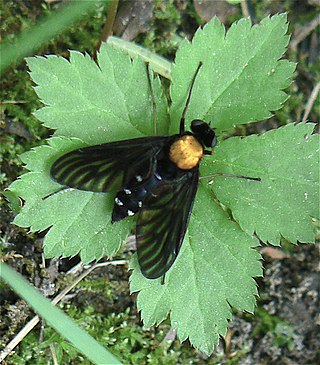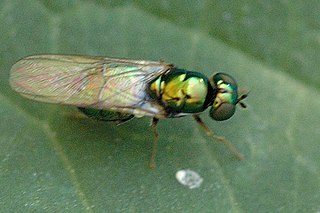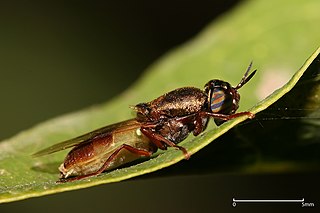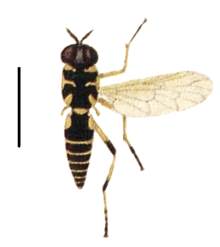
Chrysopilus is common, worldwide genus of predatory snipe flies. There are approximately 300 species in the genus, including fossil members that are sometimes found in amber.

Xylomyidae is a family of flies known commonly as the wood soldier flies. They are xylophagous and are associated with dead or dying wood.

Rhagionidae or snipe flies are a small family of flies. They get their name from the similarity of their often prominent proboscis that looks like the beak of a snipe.

Rhagio is a worldwide genus of predatory snipe flies. Several species in this genus are referred to as downlooker or down-looker flies because they sometimes perch on tree trunks in a head-down position. There are approximately 170 species. They can be distinguished from other rhagionids by the open anal cell on the wings and the lack of a kidney-shaped arista.

Symphoromyia is a genus of predatory snipe flies. Unusually for Rhagionids, some species of Symphoromyia are known to feed on mammal blood, including human blood. Symphoromyia species are stout bodied flies from 4.5 to 9 mm and with a black, grey or gold thorax, and the abdomen is coloured grey, black, or both black and yellow, black terminating with yellow, to completely yellow. The wings are hyaline or lightly infuscate.

Microchrysa is a genus of soldierfly belonging to the family Stratiomyidae. There has been some confusion with the synonym Chrysomyia of Macquart, 1834, causing some members of the genus Chrysomya of Robineau-Desvoidy, 1830 to be placed erroneously in this genus.

Odontomyia is a genus of soldier flies in the family Stratiomyidae.

Pachygaster is a genus of flies in the family Stratiomyidae.

Oxycera is a genus of flies in the family Stratiomyidae.

Clitellaria is a genus of flies in the family Stratiomyidae.

Beris is a genus of flies in the family Stratiomyidae. They are small flies with reduced palpi. The scutellum has spines and the abdomen has seven visible segments. Their eyes are contiguous in the male.

Rachicerus is a genus of flies in the family Xylophagidae.

Solva is a fly genus in the family Xylomyidae, the "wood soldier flies".

Acrocera is a genus of small-headed flies in the family Acroceridae.

Dialysis is a genus of flies in the family Xylophagidae.

Adoxomyia is a genus of soldier flies in the family Stratiomyidae.

Xylophagus is a genus of flies in the family Xylophagidae.
Suragina is a genus of flies in the family Athericidae.
Odontosabula is a genus of flies in the family Xylophagidae.
















